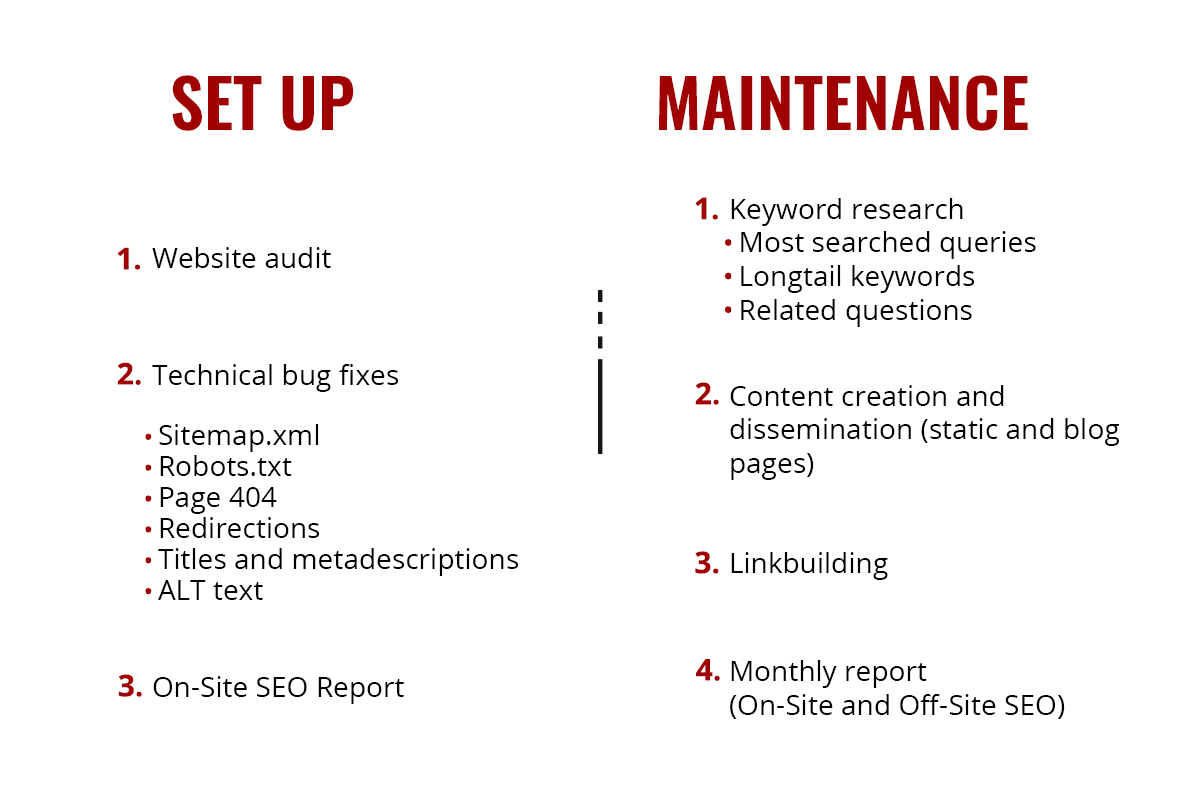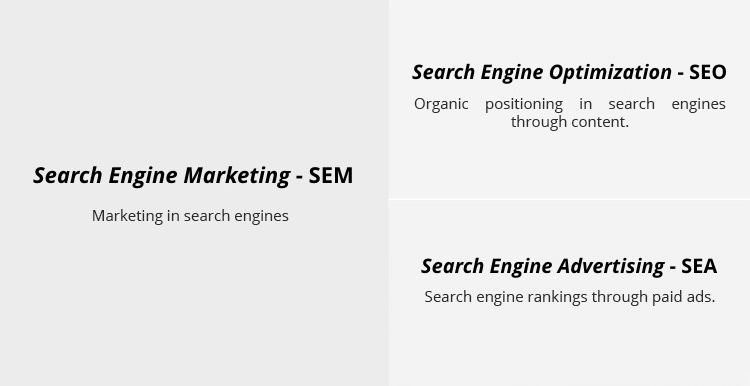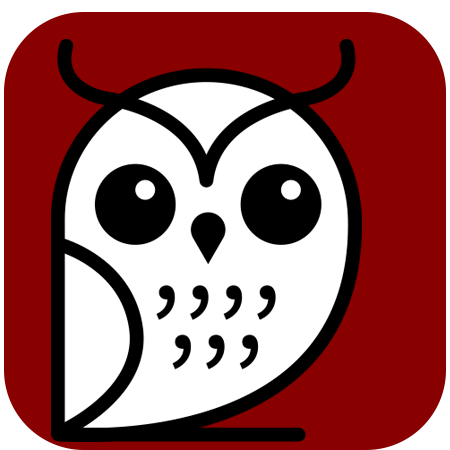

SEO Process
Organic search engine optimization has two main types of optimization:
On Site SEO. It corresponds to all the factors that are within your site, how it is configured and how the contents that it has are written and tagged.
Off Site SEO. It corresponds to all the external factors to your site that generate organic traffic, that is, that make people reach your page without having to pay for advertising.
At Laetas we do an initial SEO Set Up of your website and a monthly SEO Maintenance..
Methodology for SEO Set Up
At Letras Laetas we use an SEO On Site methodology in three simple steps:
- Website audit. We analyze the structure, the content and the way search engines are seeing your website.
- Technical bug fixes. Based on the previous analysis, we proceed to correct the technical bugs that your website could have.
- Report of changes made. Once we implement these changes, we make a report of the modifications.
1. Website audit
There are multiple tools out there to perform SEO audits on a page. The purpose of using them is to quickly detect which are the areas of opportunity a website has, and proceed to its optimization.
2. Technical bug fixes
These are the main technical factors that are corrected in SEO On Page, if you are not familiar with the terminology, you can read more details in our blog:
Indexing and crawlability
- Sitemap.xml: This file contains all the URLs of your website and is used by the search engine to understand its structure and what content it must index, it can be said that it is the index of your site in the eyes of the search engine.
- Robots.txt: Contrary to the previous file, this one indicates to the search engine which are the pages that should not be indexed; for example, the login page.
- Page 404: If a user searches for a path that does not exist within your domain, for example, Tiendademaria.com/tosaysomething, they will arrive at this page indicating that this content does not exist and will invite them to visit another page of the site.
- Status code 4xx and 5xx: Refers to HTTP responses that are errors from the client or the server. For example, verify that there is enough storage space for a resource. Status code 4xx and 5xx:
Redirects
- Non-duplicated HTTP and HTTPS: An SSL certificate serves to verify that it is an official page; when installed the site url changes from HTTP to HTTPS and you need to make sure the installation is done correctly.
- www and non-www versions: It is necessary to establish if our website will be mounted on the domain with www or without it and that an appropriate redirection be made to the favorite version without duplicating content.
- Redirect 301 and 302: If you change the URL of a page of your site; For example, if Maria changed Tiendademaria.com/products to Tiendademaria.com/products-and-services, it is necessary that the first address redirects to the new one so as not to lose visits and authority.
- Pages with rel=“canonical”: If Maria’s site has an ecommerce with options to filter by price, best sellers, etc. The original page should be indicated with this tag to prevent search engines from identifying it as duplicate content.
SEO OnPage: Tagging of pages and images
Titles: The title is the name of your content. Ideally, it should be attractive, descriptive, contain a keyword and have a specific extension.
Meta descriptions: It is a tag that provides a small summary of what is found on each page. It is only visible in search engine results.
ALT in images: Although we can’t see this tag, the images must contain an ALT text, which is what will be displayed if a person’s internet connection is slow and won’t load the images. This tag is also put for accessibility reasons. With it, visually impaired people who visit your site can understand, through an audio tool, what your image is about.
3. On Page SEO Report
An SEO On Page report can include the changes made to a site and what was achieved by making them; for example, the appearance of the site in search engines in terms of titles, meta descriptions and the other aspects mentioned above.
Methodology for SEO maintenance
Our methodology for SEO Off Page is divided into the following steps:
1. Creating a blog on the website
Having a blog helps you communicate with your potential customers. It is a non-invasive type of advertising that gives your customers useful information of your products and services. Plus, it helps to keep you top of their minds for when they are ready to make a purchase related to your business.
2. Using relevant keywords
We carry out a study about the most used keywords related to your brand. Therefore, you will know how users are looking for information on the web related to your activities. A study of keywords will help you determine:
- Positioning difficulty: Some words are more difficult to position than others. By knowing the difficulty, you can choose the best terms.
- Longtails: These are longer terms, such as questions or phrases. For example, instead of searching to position ‘flower shop’, María can decide on ‘flower shops home delivery at cdmx’.
- Related questions: Currently many users use search engines as an oracle, so you can use questions as subtitles for your content.
3. Content writing
Once you are clear about your intentions and the words you want to position, the next part of the process is compose optimized notes and upload them to your site with the corresponding tags and parameters for SEO.
4. Link building strategy
Once those notes are on your site, it is necessary to put them in motion through different social networks, Internet forums, among others, so that more people see and share them. Also, we look for other websites related to your activity and get them to link to your page.
5. Off Page SEO Report
Finally, we can measure the results of your content strategy on a quarterly basis by seeing what positions you have gained in search engines. For example, in the case of María, ‘flower arrangements for weddings’ position 1 in Google, ‘flowers for quinceañera parties’ position 3 in Google, etc.
FAQ
Having a digital presence is essential for any type of industry, organic search engine positioning ensures that our company appears on the first page of search engines and increases the chances of getting new customers.
Search Engine Optimization or SEO, consists of a series of techniques to get a web page to appear in the first positions in search engines such as Google, Yahoo or Bing, and even on other platforms like YouTube, without paying ads for it.
It forms part, along with Search Engine Advertising or SEA, of what is known as search engine marketing or Search Engine Marketing (SEM). SEO, unlike SEA, is based on digital content to position itself organically,, that is, to appear in search engines without the need to pay for ads. By content we mean all text (such as blog posts), images (photos, infographics, gifs, etc.), video or audio (such as podcast) that Internet users find on the web.

Let’s say, for example, that María sells flowers and has a shop in Colonia Condesa. She created a web page through which she shows her catalog of products and services such as ‘flower arrangements for weddings’, ‘table centerpieces for XV years’, etc.
SEO takes care of the following:

- Technical aspects. That Maria’s site is built in a way that search engines can understand its structure and content.
- Relevant content. That the content that Maria puts on her page is valuable to her audience and that it is written with the terms with which people search for her services.
- Registration in directories. That Maria’s flower shop appears in the most common directories and those that are specific to her industry and location; in this case, for example, in Google, directories of event organization pages, weddings, party halls, etc.
- Traffic sources: That people come to Maria’s content not only through the search engine, but also because:
– They recommended it on an Internet forum
– They saw it on one of their social media
– They mentioned her on another website that talks about weddings or something that is relevant to their potential client
In this way, when a person who is in the city where Maria’s store is, searches Google for a term related to her services, they will arrive at her web page. As Maria’s site is better optimized, it will gain domain and page authority and will be considered more relevant by the search engine.
The SEO is a marketing strategy for all the people who have a website and wants to reach potential customers, when they make queries for specific terms. It is useful for:
- Businesses that operate on the web, such as ecommerce, or that has an online catalog of products.
- Companies that want to reduce their advertising costs on Google (or SEA, Search Engine Advertising).
- Digital magazines that want their content to have good visibility in search engines.
- People with projects on digital platforms: personal websites, work portfolios, among others.
Prices may vary according to the needs of each project. An SEO quote can be done:
- By number of pages: The more pages to optimize, the higher the price. Optimizing a 10 page site is not the same as optimizing a 1600 page site.
- By number of terms and positioning difficulty: For example, if you want to appear with all the terms related to your products and services, it is necessary to carry out a study of which ones would be more convenient and feasible to position. As we have already seen, some keywords are more competitive than others.
You’ll may be interested…
A selection from our blog.
Is your company looking for a content marketing solution?
We are ready to make your ideas come true. Let’s talk about it!




